An on-grid solar system connects directly to the electricity grid, allowing homes and businesses to reduce energy bills and earn credits through net metering programs.
1.1 Definition and Function
An on-grid solar system is a renewable energy setup that connects directly to the electrical grid, enabling homes and businesses to use solar power while maintaining grid connectivity. Its primary function is to convert sunlight into electricity using solar panels, which is then fed into the grid through an inverter. This system allows users to reduce their reliance on utility-provided electricity, lowering energy bills and carbon emissions. Unlike off-grid systems, on-grid setups do not require batteries for energy storage, as excess energy is sent back to the grid and credited through net metering programs. The wiring diagram for such systems illustrates the flow of energy from panels to the grid, ensuring safe and efficient operation.
1.2 Comparison with Off-Grid Systems
On-grid solar systems differ significantly from off-grid systems in their functionality and requirements. On-grid systems are directly connected to the electrical grid, enabling two-way energy flow—sending excess energy to the grid and drawing energy when needed. In contrast, off-grid systems operate independently without grid connectivity, relying on battery storage for excess energy. Location and energy needs primarily dictate the choice: off-grid is ideal for remote areas lacking grid access, while on-grid suits locations with reliable grid services. On-grid systems typically require inverters and meters for grid synchronization, whereas off-grid systems need batteries and charge controllers. Both systems aim to reduce reliance on non-renewable energy but cater to different infrastructure and lifestyle demands. Understanding these distinctions aids in selecting the most suitable system for specific circumstances.
1.3 Benefits of On-Grid Systems
On-grid solar systems offer numerous advantages, primarily reducing electricity costs by harnessing solar energy to power homes and businesses. They enable users to reduce grid reliance while maintaining connectivity for energy stability. Unlike off-grid systems, on-grid setups allow for net metering, where excess energy is exported to the grid, earning credits or revenue. This feature maximizes energy efficiency and financial returns. Additionally, on-grid systems are environmentally friendly, lowering carbon footprints by utilizing renewable energy. They also require less upfront investment compared to off-grid systems, as they don’t need batteries for energy storage. Furthermore, governments often provide financial incentives for installing on-grid solar systems, making them a cost-effective and sustainable choice for many users.

Key Components of an On-Grid Solar System
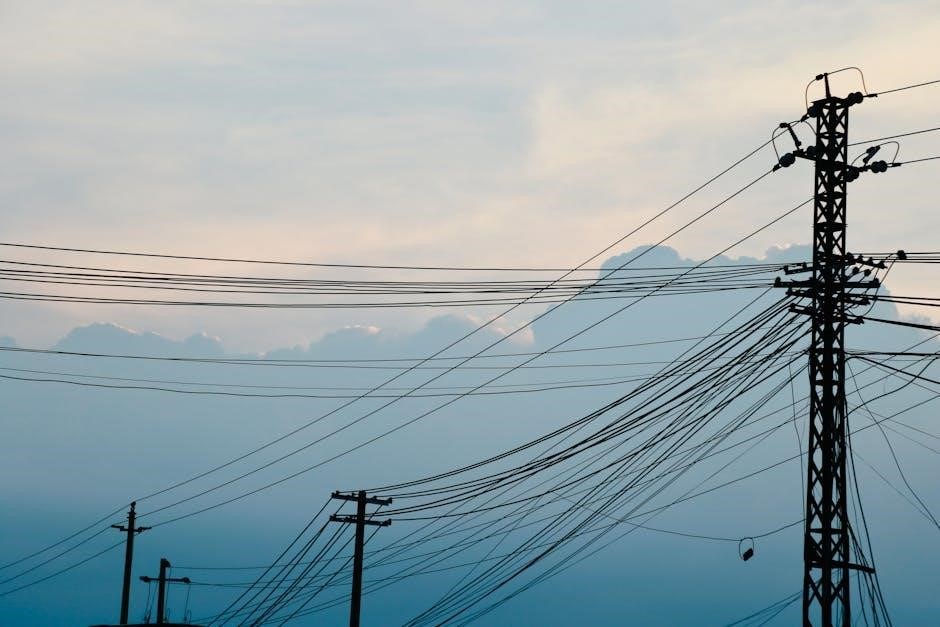
An on-grid solar system includes solar panels, an inverter, mounting structures, wiring, and a metering system to ensure efficient energy production and grid synchronization.
2.1 Solar Panels
Solar panels are the cornerstone of an on-grid solar system, converting sunlight into electricity. They are typically made of monocrystalline or polycrystalline cells, offering varying efficiencies. Proper orientation and placement are critical to maximize energy production. Panels must be installed on a stable structure to withstand weather conditions. The system’s size depends on energy needs and available space. Regular maintenance, such as cleaning, ensures optimal performance. High-efficiency panels, like the 545W JAS PV panels mentioned in some setups, are popular for their power output. Proper wiring, as shown in wiring diagrams, ensures safe and efficient energy flow to the inverter and grid.
2.2 Inverter Types
Inverters are crucial for converting DC power from solar panels to AC power for grid use. Common types include string inverters, microinverters, and power optimizer systems. String inverters are the most widely used, offering cost-effectiveness for small to medium systems. Microinverters provide panel-level optimization, improving efficiency and flexibility, especially for shaded or uneven installations. Power optimizers work with string inverters to maximize energy output by adjusting voltage at the panel level. Inverter sizing is essential to match system requirements, as highlighted in guides for selecting the optimal solar inverter size. Proper inverter configuration ensures seamless grid integration and energy monitoring, addressing issues like low voltage or zero power output effectively.
2.3 Mounting Structures
Mmounting structures are essential for securing solar panels in optimal positions to maximize energy capture. Fixed-tilt mounts are the most common, offering simplicity and cost-effectiveness, while adjustable-tilt mounts allow seasonal modifications for better efficiency. Tracking systems, though more complex, follow the sun’s movement to capture maximum sunlight; Roof-mounted systems are popular for residential use, whereas ground-mounted structures suit larger, open spaces. Durable materials like aluminum and steel ensure longevity. Proper installation ensures stability and alignment, minimizing wear and tear. Mounting structures must comply with local building codes and load-bearing capacities. They play a critical role in the overall efficiency and safety of an on-grid solar system.
2.4 Wiring and Connections
Proper wiring and connections are crucial for ensuring the safety and efficiency of an on-grid solar system. The wiring diagram serves as a blueprint, guiding the installation process. It begins with connecting solar panels in series or parallel to achieve the desired voltage and current. The output is then directed to the inverter, which converts DC power to AC. The AC output is connected to the main electrical panel, integrating it with the grid. All connections must be secure, using appropriate gauge wires and connectors to minimize resistance and heat buildup. Grounding is essential to prevent electrical hazards. Regular inspections and adherence to local electrical codes ensure compliance and safety. Proper wiring ensures reliable energy flow and system performance.
2.5 Metering Systems
Metering systems are essential for monitoring energy production and consumption in an on-grid solar system. A bi-directional meter measures both the energy drawn from the grid and the excess energy fed back. This data is crucial for calculating net metering credits, ensuring accurate billing, and optimizing energy use; The metering system is typically installed between the inverter and the main electrical panel, as shown in most wiring diagrams. It provides real-time insights into system performance, helping homeowners and businesses track their energy savings. Advanced meters may integrate with monitoring software, offering detailed analytics. Proper installation and configuration of metering systems ensure compliance with utility requirements and maximize the benefits of grid-tied solar installations. Regular checks are recommended to maintain accuracy and reliability.
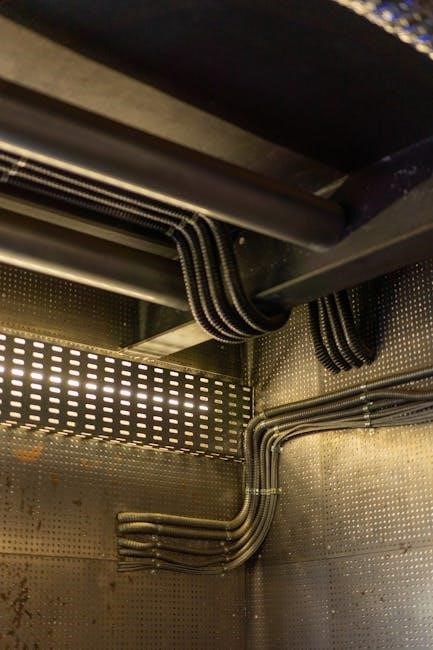
Wiring Diagrams for On-Grid Systems
Wiring diagrams provide a detailed visual guide for connecting solar panels, inverters, and grid components. They ensure safe and efficient installation, complying with electrical standards and codes.
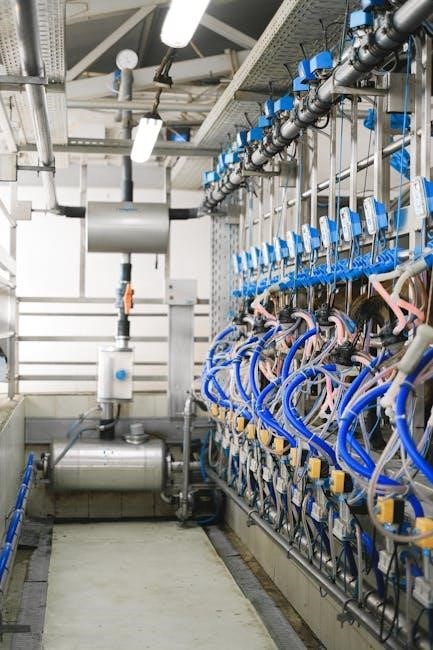
3.1 Understanding Wiring Diagrams
Wiring diagrams are essential for installing and troubleshooting on-grid solar systems. They provide a visual representation of how components like solar panels, inverters, and meters connect.
These diagrams ensure safety by illustrating proper connections, preventing short circuits, and adhering to electrical codes.
Understanding wiring diagrams helps in identifying series or parallel configurations, which optimize energy flow and system performance.
Color-coded lines and symbols simplify comprehension, making it easier to trace power pathways.
They also guide installers in compliance with local regulations and manufacturer specifications.
Regularly reviewing wiring diagrams ensures efficient system operation and simplifies maintenance or upgrades.
3.2 Series vs. Parallel Configurations
In on-grid solar systems, solar panels can be connected in series or parallel configurations, each offering distinct advantages.
Series connections increase the system voltage while maintaining current, suitable for higher voltage requirements.
Parallel connections combine currents, keeping voltage consistent, ideal for systems needing higher current capacity.
The choice between configurations depends on the inverter’s specifications and the system’s voltage and current requirements.
Proper configuration ensures optimal energy production and compatibility with inverters and other components.
Wiring diagrams detail these configurations, guiding installers to achieve the desired electrical parameters.
Understanding both setups is crucial for maximizing efficiency and ensuring safe, reliable system operation.
3.3 Safety Considerations in Wiring
Ensuring safety in on-grid solar system wiring is critical to prevent hazards and maintain reliability. Proper insulation and secure connections are essential to avoid arcing and overheating. Grounding systems must be installed correctly to protect against electrical shocks and surges. Surge protection devices and circuit breakers should be integrated to safeguard the system from power surges and overloads. Wiring diagrams must be followed meticulously to comply with local electrical codes and standards. Regular inspections and maintenance are vital to identify and address potential issues before they escalate. Using high-quality, certified components ensures durability and adherence to safety protocols. Always consult a licensed electrician for complex installations to guarantee a safe and efficient system.
3.4 Troubleshooting with Diagrams
Wiring diagrams are indispensable for troubleshooting on-grid solar systems, providing a clear visual guide to identify and resolve issues. Common problems like zero power output or low voltage can often be traced to faulty inverters, incorrect configurations, or loose connections. By referencing the diagram, technicians can pinpoint where the system deviates from normal operation. For instance, if the inverter fails to export power, the diagram helps verify if the metering setup or grid connection is at fault. Regular inspection of the wiring layout ensures compliance with safety standards and prevents potential hazards. Diagrams also aid in diagnosing ground fault issues or mismatched panel configurations, enabling swift repairs and minimizing downtime.

Installation and Setup
Installation involves planning, component selection, and inverter configuration. Proper wiring ensures efficiency and safety. Testing is crucial to verify system performance and grid connectivity before full operation begins.
4.1 Planning and Preparation
Planning begins with assessing energy needs and site suitability. Measure roof size, sun exposure, and grid compatibility. Obtain permits and approvals. Create a detailed wiring diagram to guide installation, ensuring safety and efficiency. Consult local electrical codes; Prepare tools and materials. Ensure all components are compatible. Determine mounting locations for panels and inverters. Check for potential shading issues. Verify grid connection requirements. Develop a timeline and budget. Ensure compliance with utility regulations. Prepare backup power options if needed. Test equipment before full installation. Ensure proper grounding and safety measures. Verify all connections match the wiring diagram. Plan for future system expansion. Ensure all components are certified. Review manufacturer instructions. Prepare for potential inspections.
4.2 Component Selection
Selecting the right components is crucial for an efficient on-grid solar system. Choose solar panels with high efficiency and durability, ensuring compatibility with local weather conditions. Inverters must match the system’s power requirements and support grid connectivity. Mounting structures should be sturdy and adjustable for optimal solar exposure. Wiring and connectors must meet electrical standards to ensure safety and reliability. Battery backup systems, if required, should integrate seamlessly with the grid-tied setup. Consider energy storage options for future expansion. Ensure all components are certified and compliant with local regulations. Compare brands and prices to find the best value. Refer to the wiring diagram to ensure all parts are compatible. Prioritize components with extended warranties and reliable customer support.
4.3 Inverter Configuration
Configuring the inverter is a critical step in setting up an on-grid solar system. Ensure the inverter is compatible with the grid’s voltage and frequency requirements. Set the inverter to grid-tie mode, enabling it to synchronize with the utility supply. Configure the maximum power point tracking (MPPT) settings to optimize energy production. Enable anti-islanding protection to ensure safety during grid outages. Set up the inverter’s monitoring system to track performance in real-time. Refer to the wiring diagram to connect the inverter correctly to the solar panels and grid. Adjust settings for zero export if required by local regulations. Test the inverter’s response to grid fluctuations. Ensure all safety features, like ground fault protection, are enabled. Proper configuration ensures efficient energy production and compliance with grid standards.
4.4 System Testing
After installation, thorough testing ensures the on-grid solar system operates safely and efficiently. Begin by verifying all electrical connections using a multimeter to check voltage and current. Test the inverter’s operation, ensuring it functions within specified voltage and frequency ranges. Check the anti-islanding protection to prevent unsafe conditions during grid outages. Validate the monitoring system’s accuracy to track energy production and grid interaction. Test grid synchronization to ensure smooth integration with the utility supply. Conduct a full system test under varying loads and sunlight conditions to assess performance. Finally, perform an emergency shutdown test to confirm the system disconnects safely from the grid during outages or faults. Proper testing guarantees reliability and compliance with safety standards.
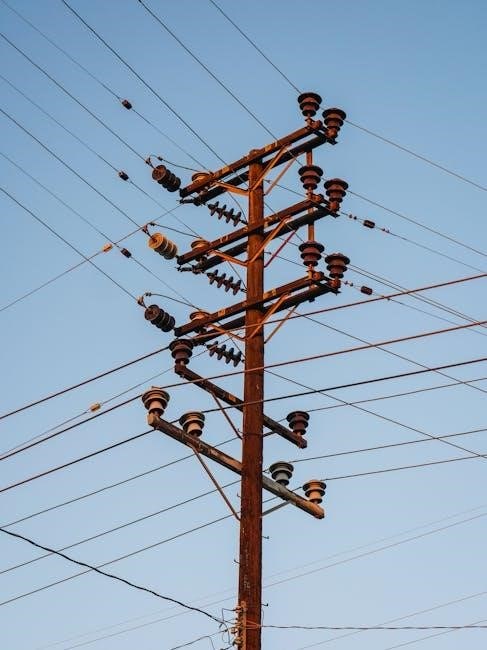
Optimizing Energy Use
Optimizing energy use involves implementing strategies to maximize solar utilization, reduce grid reliance, and efficiently manage loads, ensuring minimal energy waste and higher system efficiency overall.
5.1 Reducing Grid Reliance
Reducing grid reliance involves maximizing the use of solar energy and minimizing dependence on utility-provided electricity. This can be achieved by optimizing solar panel efficiency, using energy storage systems, and implementing load management techniques. Solar panels generate electricity during daylight hours, which can be stored in batteries for nighttime use. Load management tools help prioritize energy usage, ensuring essential appliances receive power first; Additionally, monitoring systems provide insights into energy consumption patterns, allowing homeowners and businesses to make informed decisions. By integrating these strategies, users can significantly lower their grid reliance and enjoy greater energy independence while maintaining a stable power supply. Proper wiring diagrams ensure safe and efficient system operation.
5.2 Utilizing Feed-in Tariffs
Feed-in tariffs allow solar system owners to earn credits or payments for excess energy exported to the grid. This incentive encourages renewable energy adoption by rewarding homeowners and businesses for their surplus production. By leveraging these tariffs, users can offset their energy bills and reduce grid reliance. Proper wiring diagrams ensure efficient energy flow and accurate metering, essential for tracking exported energy. Monitoring tools help users optimize their systems to maximize feed-in benefits. Compliance with local regulations and utility requirements is crucial to participate in these programs effectively. Over time, feed-in tariffs can significantly enhance the financial returns of an on-grid solar system, making it a viable and sustainable energy solution.
5.3 Load Management Techniques
Load management techniques optimize energy distribution in on-grid solar systems, ensuring efficient use of generated power. By prioritizing solar energy during daylight and storing excess for nighttime, users can reduce grid dependency. Smart inverters play a crucial role in balancing energy flow and managing loads effectively. Monitoring tools enable real-time tracking of consumption and production, allowing adjustments to minimize grid reliance. Techniques like load shedding and peak demand management help stabilize the system and prevent overloading. These strategies not only enhance energy efficiency but also contribute to grid stability, making solar systems more sustainable and user-friendly. Proper wiring diagrams ensure seamless integration of these techniques into the overall system design.
5.4 Monitoring Tools
Monitoring tools are essential for tracking and optimizing on-grid solar system performance. These tools provide real-time data on energy production, consumption, and grid interaction. Advanced software platforms offer detailed insights into system metrics, such as voltage, current, and power output. Users can access historical data to identify trends and potential issues. Many systems integrate with mobile apps, enabling remote monitoring and control. These tools also support load management by analyzing energy usage patterns and suggesting efficiency improvements. Additionally, they can detect faults and alert users to maintenance needs. By leveraging monitoring tools, homeowners and businesses can maximize their solar system’s efficiency and reduce grid reliance effectively. These tools are a cornerstone of modern solar energy management.
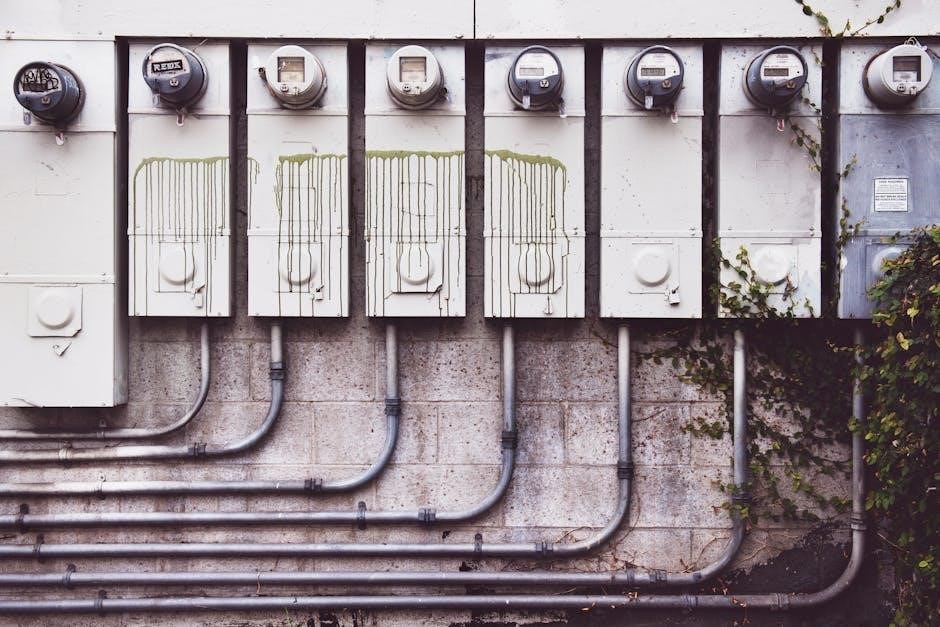
Troubleshooting Common Issues
Troubleshooting common on-grid solar issues involves identifying faults like low voltage or zero power output. Use wiring diagrams to trace connections and resolve errors efficiently.
6.1 Addressing Low Voltage Issues
Low voltage issues in on-grid solar systems often stem from incorrect wiring or component malfunctions. Reference the wiring diagram to ensure all connections are secure and properly sized. Check the inverter settings and battery charge levels. If issues persist, inspect the solar panels for shading or damage. Ensure the system’s voltage specifications match the grid requirements. Consulting a certified electrician can help resolve complex problems. Regular maintenance and monitoring are crucial to prevent voltage drops and ensure optimal system performance. Always follow safety guidelines when troubleshooting electrical systems.
6.2 Resolving Zero Power Output
Zero power output in an on-grid solar system is often due to inverter faults or disconnections. Check the wiring diagram for loose connections or tripped circuit breakers. Ensure solar panels are clean and unshaded. Verify inverter settings and grid synchronization. If issues persist, inspect the metering system for errors. Restart the system after addressing potential faults. Monitor performance using monitoring tools to identify root causes. Always refer to the wiring diagram for troubleshooting guidance. Professional assistance may be needed if the problem is complex or recurring. Regular system checks can prevent unexpected power outages and ensure continuous energy generation. Addressing these issues promptly helps maintain optimal system efficiency and reliability.
6.3 Identifying Inverter Faults
Inverter faults are common issues in on-grid solar systems, often causing zero power output. Check for error codes on the inverter display, as they indicate specific problems like grid synchronization or DC input issues. Review the wiring diagram to ensure proper connections between panels, inverter, and grid. Verify that all circuit breakers are on and no fuses are blown. Use monitoring tools to track performance and identify irregularities. If the inverter fails to communicate with the grid, consult the wiring diagram for correct configuration. Resetting the inverter or updating its firmware may resolve the issue. Persistent faults require professional inspection to ensure system reliability and safety. Always refer to the wiring diagram for troubleshooting guidance. Regular maintenance can prevent such faults and ensure optimal energy production. Addressing inverter issues promptly minimizes downtime and maintains grid connectivity.
6.4 Checking Electrical Connections
Ensuring secure electrical connections is crucial for on-grid solar system performance. Begin by reviewing the wiring diagram to locate all connectors and terminals. Inspect panels, inverters, and grid tie points for loose or corroded connections, which can cause power loss or safety hazards. Use a multimeter to verify voltage and resistance levels, ensuring they match specifications. Tighten any loose bolts or clips, and clean corrosion with a wire brush. Replace damaged connectors immediately. Check for proper grounding to prevent electrical shocks. Referencing the wiring diagram helps identify mismatches or incorrect configurations. Regularly scheduled inspections can prevent faults and ensure efficient energy flow. Secure connections guarantee system reliability and safety, optimizing overall performance and grid integration. Always follow safety protocols when handling electrical components to avoid risks.
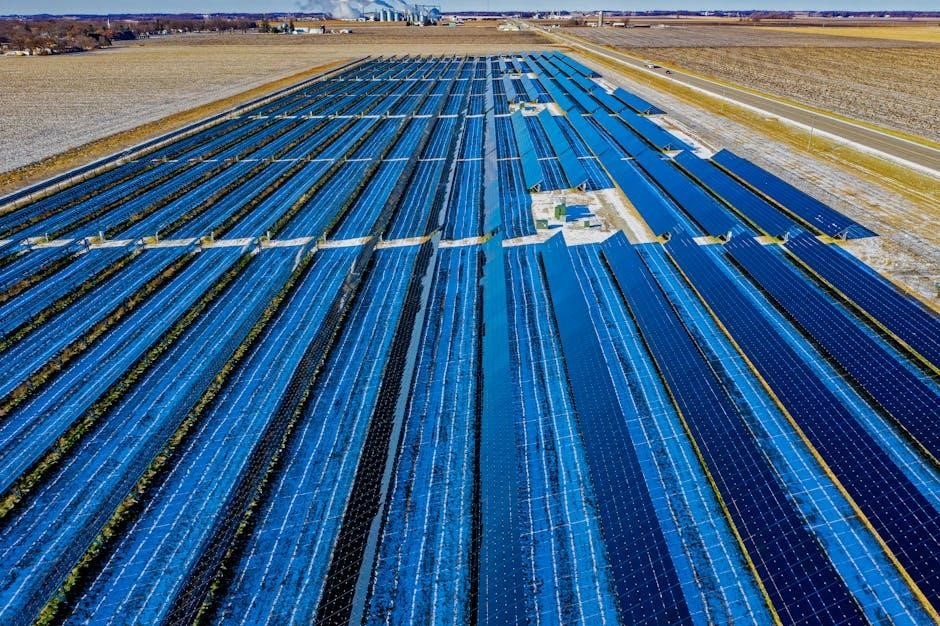
Case Studies and Applications
Residential systems often use 10-20 panels, reducing energy bills by 50-70%. Commercial setups, like warehouses, employ 50+ panels, cutting costs significantly. Industrial applications integrate large-scale arrays for factories, ensuring reliable power supply and reducing carbon footprint. These examples highlight practical on-grid solar implementations, showcasing efficiency and scalability across various sectors.
7.1 Residential Solar Systems
Residential on-grid solar systems are designed to meet household energy needs, reducing reliance on utility grids. They typically include 10-20 solar panels, inverters, and mounting structures. Homeowners benefit from lower electricity bills and potential net metering credits. Wiring diagrams ensure safe connections between panels, inverters, and the grid. Proper installation and configuration maximize efficiency, while monitoring tools track energy production. These systems are scalable, adapting to varying household sizes and energy demands. They also qualify for incentives, making them a cost-effective choice for eco-conscious homeowners seeking to reduce their carbon footprint and energy expenses. This setup is ideal for urban and suburban areas with stable grid access.
7.2 Commercial Solar Examples
Commercial on-grid solar systems are widely adopted by businesses to reduce operational costs and environmental impact. Warehouses, retail stores, and offices often install large-scale systems to meet their high energy demands. These systems typically feature multiple solar panels connected in series or parallel, with advanced inverters to optimize energy production. Wiring diagrams ensure safe and efficient connections, while net metering allows businesses to sell excess energy back to the grid. Companies like warehouses and manufacturing facilities benefit from reduced energy bills and stable power supply. Scalable designs cater to varying energy needs, making on-grid solar a practical choice for commercial establishments aiming to lower their carbon footprint.
7.3 Industrial Solar Applications
Industrial solar applications represent a significant sector leveraging on-grid systems to power large-scale operations. Factories, manufacturing plants, and industrial complexes utilize high-capacity solar arrays to meet substantial energy demands. These systems often integrate advanced inverters and monitoring tools for optimal performance. Wiring diagrams play a crucial role in ensuring safe and efficient energy distribution across industrial facilities. Industries benefit from reduced operational costs and enhanced reliability, while contributing to sustainability goals. With the ability to scale, industrial solar installations are increasingly adopted worldwide, supporting both production processes and auxiliary power needs, making them a cornerstone of modern renewable energy strategies. This approach aligns with global efforts to decarbonize industrial sectors.
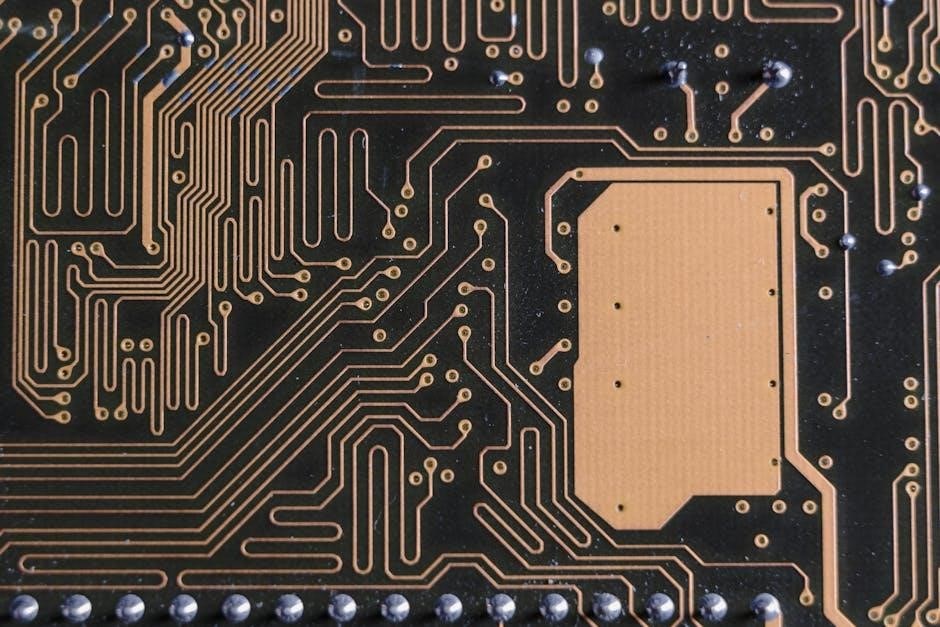
Future Trends and Innovations
The on-grid solar industry is evolving rapidly, driven by innovations in smart inverters, energy storage, and AI-driven systems. These advancements enhance efficiency, reliability, and grid integration capabilities, paving the way for a sustainable energy future.
8.1 Smart Inverters
Smart inverters are revolutionizing on-grid solar systems by enabling advanced energy optimization and grid stability. These intelligent devices can dynamically adjust their operation based on real-time grid conditions, ensuring efficient energy flow and reducing strain on the electrical grid. Unlike traditional inverters, smart inverters can communicate with the grid and other system components, allowing for real-time monitoring and control. This capability enhances energy efficiency and enables features like grid support and frequency regulation. Smart inverters also support energy storage integration, making it easier to manage excess solar production and reduce grid reliance. As technology advances, smart inverters will play a crucial role in creating a more resilient and sustainable energy system.
8.2 Energy Storage Integration
Energy storage integration is a transformative advancement in on-grid solar systems, enabling users to store excess solar energy for later use. This technology reduces reliance on the grid during peak demand or power outages. By incorporating batteries and advanced management systems, homeowners and businesses can optimize their energy consumption. Stored energy can be used during nighttime or cloudy days, enhancing self-sufficiency. Modern systems often include smart inverters that seamlessly manage energy flow between solar panels, batteries, and the grid. This integration not only improves energy efficiency but also provides backup power, ensuring continuity during grid failures. As battery technology evolves, energy storage will become even more central to on-grid solar setups.
8.3 AI in Solar Systems
Artificial Intelligence (AI) is revolutionizing on-grid solar systems by enhancing efficiency and performance. AI algorithms analyze real-time data from solar panels, inverters, and grid connections to optimize energy production and consumption. Predictive maintenance is a key application, where AI detects potential faults before they occur, minimizing downtime. Load balancing and energy forecasting are also improved through AI, ensuring optimal use of solar power. Additionally, AI-driven smart inverters adapt to grid conditions, stabilizing energy flow. As AI technology advances, it will play a crucial role in integrating solar systems with smart grids, creating a more sustainable and responsive energy ecosystem for future generations.
8.4 Advancements in Net Metering
Advancements in net metering have significantly enhanced the efficiency and profitability of on-grid solar systems. Modern net metering systems now incorporate smart meters that provide real-time energy production and consumption data, enabling precise tracking of energy credits. Governments and utilities are expanding net metering programs, allowing more households and businesses to benefit from solar energy. Additionally, digital platforms now offer automated meter readings and seamless credit calculations, reducing administrative burdens. These advancements ensure fair compensation for excess energy exported to the grid, making solar adoption more attractive. Furthermore, some regions are introducing time-of-use pricing, optimizing energy savings and encouraging smarter energy management strategies for solar users.
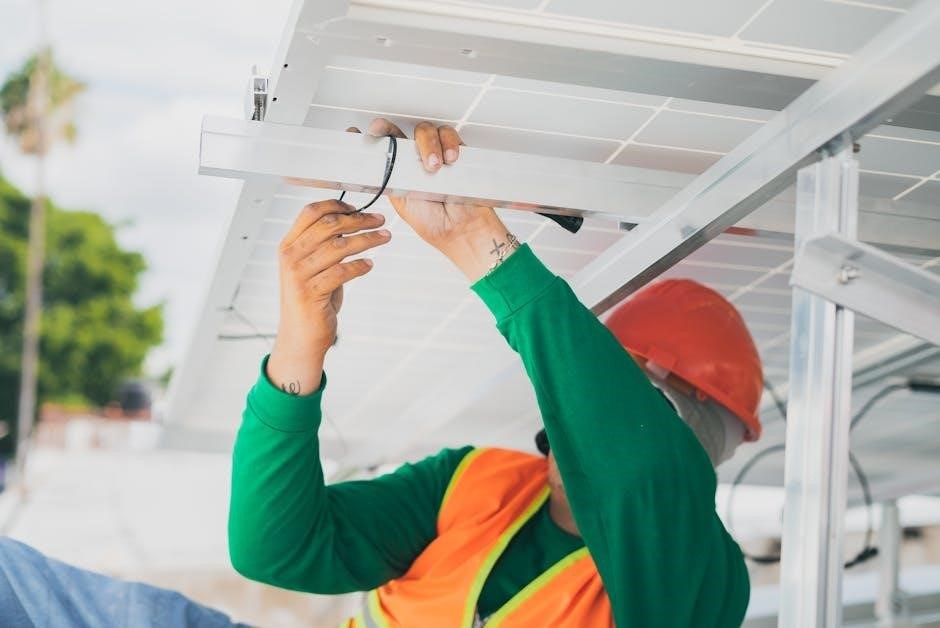
No Responses